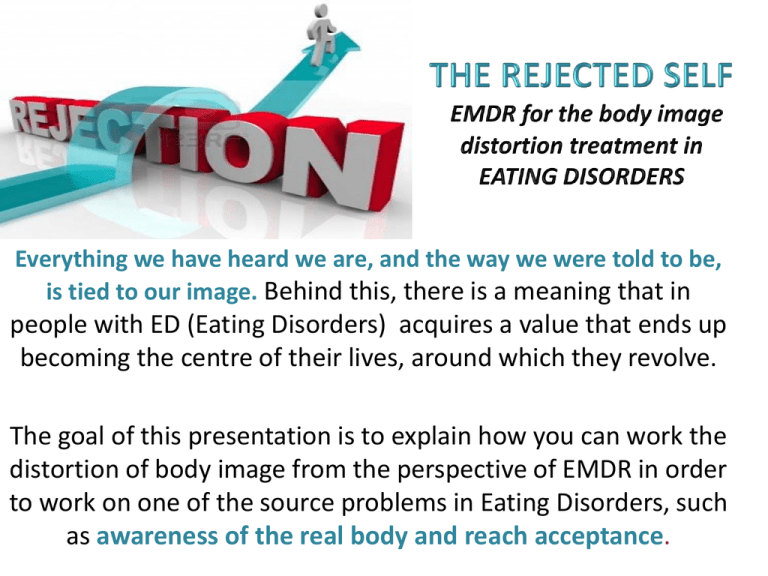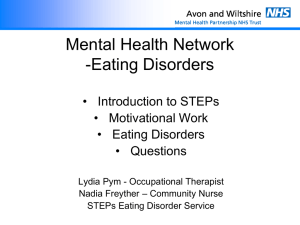what is body image?
advertisement

Everything we have heard we are, and the way we were told to be, is tied to our image. Behind this, there is a meaning that in people with ED (Eating Disorders) acquires a value that ends up becoming the centre of their lives, around which they revolve. The goal of this presentation is to explain how you can work the distortion of body image from the perspective of EMDR in order to work on one of the source problems in Eating Disorders, such as awareness of the real body and reach acceptance. WHAT IS BODY IMAGE? One of the first definitions of body image is: • The image we create in our mind regarding our own body, it means, the way we see ourselves. Schilder (1935) • In addition to the perception of our body, including the assessment of our size, there is an emotional or attitudinal image, an evaluation, that is, the way we feel about it. • This is the aspect that we usually focus when we talk about negative body image in people with Eating Disorders, using body dissatisfaction or rejection. WHAT IS DEFINED AS BODY IMAGE PROBLEM? – A NEGATIVE BODY IMAGE may involve a dissatisfaction or a negative evaluation of a physical element or even an extreme obsession with the physical aspect to the detriment of normal functioning. (Lorraine Bell, 2010) • Summary: Perceptual Distortion Failure to meet the unrealistic targets of size and weight that lead to body image dissatisfaction. THE CONCEPT Thompson (1992) proposed the concept of BODY IMAGE DISORDER as a persistent state of dissatisfaction and worry related to some aspect of body image. BODY DISSATISFACTION PERCEIVED SELF DISCREPANCY IDEAL SELF Body Image Negative Body Image Body Image Disorder WHAT IS BODY DIMORPHIC DISORDER? (I) • Body Dimorphic Disorder (BDD) is an absolute concern for a physical defect or a defect perceived as it seems. • leads to great stress and is not caused by another disorder such as anxiety disorder, OCD, major Depression. • It is likely to occur with Eating Disorders. • The concern is directed to an obsessive body checking, skin picking, spending excessive time to camouflage the defect, social anxiety, unnecessary treatments and surgeries and sometimes self-harm or suicide. WHAT IS BODY DIMORPHIC DISORDER? (II) • In most studies concern appears in adolescence or early adulthood, however, studies find BDD in people of all ages and both genders. • People with BDD seek medical advice because of losing jobs, studies anxiety, relationship problems but not by the BDD itself, because they have many difficulties to recognize that their perception is distorted. Muscle Dysphormia disorder (MDD) Bigorexy • Muscle Dysphormia (or more informally bigorexy) is a disorder in which a person become obsessed with the idea that they don´t have muscles enough. • Is a very specific type of body dysmorphic disorder, the person is preoccupied with thoughts concerning apperance, specially muscles. • Researchs have identified that AN and Mucle Dysmorhia have a strong connection to low selfesteem commonly sprouting from chilhood abuse. BODY IMAGE DISTORTION IN EATING DISORDERS • University of Illinois professor Janet M. Liechty conducted a research study concluding that body-image distortion predicts future unsafe weight-loss behaviors in young females. • She says “usually, teens and their parents only get weight-related feedback from the doctor when the child is overweight. But kids of any weight can struggle with body-image and poor-image can negatively affect medical outcomes in ways we often don´t recognize”. • Is the other side of the coin of body image distortion. • It is not inside of the eating disorders box yet • People see themselves as thin, but they are actually overweight. • People who suffer from fatorexia have excessive weight and fail to notice it. On the contrary, they see themselves as thin and healthy. THE REJECTED SELF IMAGE Rejected Self Image Ideal Self Image Distorted Self Image • It is the image of yourself from the past that you always compare yourself to and you never want to be again. - Gathering information about the default and the Rejected self. - Psycoeducation - Working with defenses. - Resources - Applying the protocol • How old were you when you first noticed the problem? • Has it always been the same area the subject of the complaint or sometimes you focus on other areas of your body? • When you think of this area of the body, what makes you believe about yourself? • How much time do you spend hiding or covering the area of your complaint? • What else was happening in your life when you were first aware of this area? • Is there someone in your family who has the same problem? Development of the protocol • We offer psychoeducation in order to recover their internal locus of control and sense of self and strengthen it. • We explain what self-esteem and self-image are. We will obtain more information through the question, "where did you learn to see yourself like that?” • We can work in multiple sessions using standard protocol to increasingly reinforce our work with the rejected self. • Rejection is not accepting, it is confronting or opposing. • Shame is not showing oneself in order to hide what is perceived as negative. • Worry protects us from going back to being what we once were. • Defenses are the mechanisms through which the internal system protects itself, so the person can become “functional” • Many times, the body, or a part of the body, is not felt as belonging to the self, it feels alien. • The fear of change is an important part of the work with body image and the rejected self that must be taken into account, particularly in Anorexia Nervosa because if the rejected self is accepted, they may begin to improve and, if so, they fear gaining weight and changing their image. • We need to take into consideration this defense in case the process becomes blocked. • EMDR works by making a floating back in time looking for the earliest or significant memories in which the person has felt or seen in the same way as is being seen in the present. • In the distortion of body image, you take the picture representing the refused self which the person does not want to be anymore, being usually the image always present and which is compared to check the body. Development of the protocol • Place the image of yourself in front of you. • It is the image you always compare yourself to and that you never want to be again. • That image has always been there all these years ... it is called the rejected self, the part of you that you do not want to be anymore. • This is the part of you that you compare yourself with. Development of the protocol • We help identify beliefs that block the development of the acceptance of the real self. • They are usually believes like: “I’m not worthy", ” I'm not pretty so no one will love me", "my body is not worthy", "there's something wrong with me" … Development of the protocol • We explore which is the image that represents her rejected self. • The patient gives us an image and we tell her to look at it and tell us if it generates any rejection, shame, or worry. These are three of the defenses that present more difficulty in working with the rejected self, but we give the patient the option to give us another defense other than these three in the way of any emotion or feeling that may come up. • The patient gives us the defenses. Development of the protocol • We work with the SUD scale of 0 to 10 for each of the defenses, just as in the standard protocol, where 0 = none and 10 = maximum. • Once the client gives us each SUD, we ask where she feels it in the body. • This is when we tell the patient to think of the image of the rejected self, we name the defenses along with the SUD and the place where she feels them, and we begin to stimulate. • We use stimulation through several sets, allowing the processing of whatever comes up, we then return to the rejected self and ask from 0 to 10 how much rejection or shame she feels when looking at her image and, once it is measured, we continue processing. Development of the protocol • We know that processing is taking place because rejection, shame, and worry start turning into sadness for this rejected self. Gradually, the defenses become weaker, giving way to the emotions that were always underneath. Development of the protocol • Once we reach this point, we measure the sadness and where it is felt in the body. We tell her to focus on that part of herself and the grief or sadness she feels for this part that has been rejected all those years, and we begin to stimulate. • Sometimes, when grief or sadness toward this part the patient may feel that the part is not her. So then, we ask her to look at the part in the eye with her imagination and to imagine that the part looks at her (Loving Eyes, Knipe) and she looks at the part, thus strengthening the bond. • We encourage integration. • We go back to the image and we check again. MATERNAL FIGURE AND THE CONSTRUCTION OF BODY IMAGE • Maternal representations play a crucial role in the construction of body image. • The attachment figure meets the criteria that Kohut attributes to the concept of self, which can be considered as the recognition and acceptance of the self. • Negative feedback from mothers about daughter´s figures and eating patterns significantly increased daughter´s difficulties in these areas. MATERNAL FIGURE AND THE CONSTRUCTION OF BODY IMAGE • Need for recognition that builds up self-esteem. • Without this recognition and validation, especially from the maternal figure, the concept of self is built from a base of insecurity. So, external confirmation will be sought in order to achieve internal validation. The mother as subject with multiple motivations • When we work with the rejected self, many times the mother figure appears as part of the processing. • As a reference figure, since it often represents the physical model from which to learn and do the modeling. • So when we process the rejected self, we also process and restore the relationship with the attachment figure. EMAIL ADDRESS NATALIA SEIJO • PSYCHOLOGIST, TRAUMA and EATING DISORDERS specialist • PRIVATE PRACTICE PSYCHOTHERAPY, TRAUMA AND EATING DISORDERS • North of Spain • seijonatalia@gmail.com










